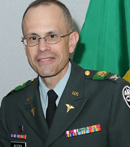In advance of World Malaria Malaria Day, ASTMH asked some of our malaria expert members and colleagues to reflect on the global fight against the disease and to peer into their crystal balls and let us know what might be on the horizon. Other interviews in this series include: Admiral Tim Ziemer of the President's Malaria Initiative, ASTMH President Alan J. Magill, ASTMH Councilor Laurence Slutsker of the CDC, Judith E. Epstein of the Naval Medical Research Center and Science Consultant Jessica Taaffe.
 Kent Kester, MD, FASTMH, Associate Vice President, Clinical and Translational Sciences, Sanofi Pastuer
Kent Kester, MD, FASTMH, Associate Vice President, Clinical and Translational Sciences, Sanofi Pastuer
Why are you drawn to malaria research?
I started working in malaria research coincident with my Infectious Disease fellowship training at the Walter Reed Army Medical Center. Fellows had the great opportunity to pursue research projects at the nearby Walter Reed Army Institute of Research (WRAIR), where tropical disease research was and continues to play a prominent role. At the time, I had the good fortune to work in a department composed of highly motivated people who truly wanted to make a difference in tropical health by way of developing an effective vaccine against falciparum malaria. To me, this embodied much of the "classical" aspects of infectious disease research, focusing on a disease for which a vaccine is not yet available yet which has a huge morbidity and mortality impact in the developing world, coupled with modern scientific approaches to vaccinology. Owing to this alignment, coupled with my later assignment at the WRAIR as a full-time malaria vaccine developer, I was privileged to play a role in the clinical development of the current lead vaccine intended to protect against falciparum malaria, RTS,S—a vaccine that is now the subject of large-scale field trials in Africa. While I’m currently working in the private sector, my focus remains the development of vaccines—products that by definition are focused on the improvement of the broader public health status of populations.
As we approach World Malaria Day, what is the biggest challenge with this disease?
There are so many needs related to malaria, whether associated with the broad areas of control, elimination, and eradication, or more finely focused on local approaches to disease prevention (e.g., via the use of bednets). In the end, the financial challenges are substantial, something that contributed negatively in the prior malaria eradication campaigns.
Where do you see the most promise?
I’m encouraged by the continued visibility of malaria as a real public health problem associated with many developing countries. Certainly, the advocacy and funding provided by the BMGF has played a major role in keeping malaria in the news. Hopefully, their continuing efforts, joined with those of others (e.g., government agencies, other nonprofit organizations, and industry) will continue to push forward on multiple fronts to effectively deal with this perennial scourge. The work is incredibly important.